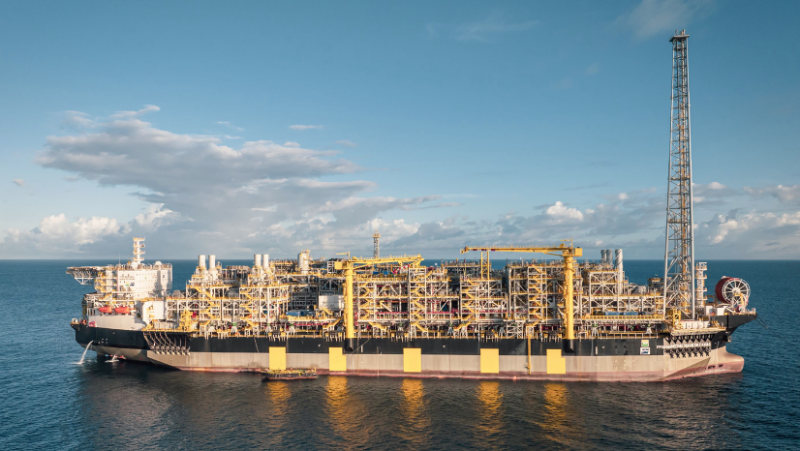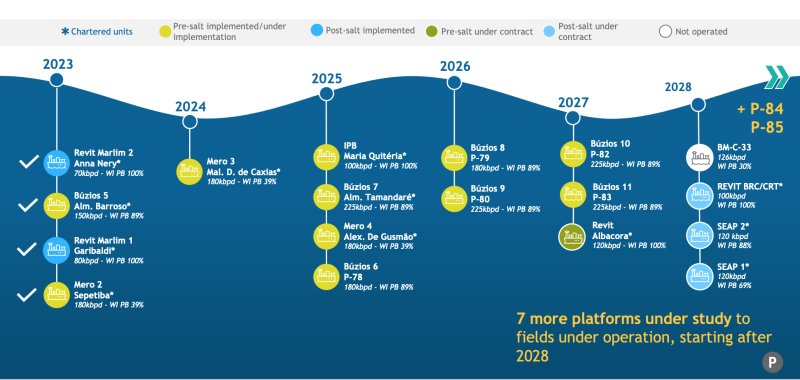Petrobras has awarded Singapore-based Seatrium O&G Americas Ltd. an $8.16-billion contract to build two all-electric FPSOs (floating, production, storage, and offloading) units that will kick off Phase 2 of production at the Atapu and Sépia fields in the ultradeep—2000 m-plus—waters of Brazil’s pre-salt Santos Basin at decade’s end.
The P-84 (Atapu) and P-85 (Sépia) FPSOs are expected to bring first oil onstream in late 2029 or early 2030, with each boasting capacities of 225,000 B/D and 10 million m3/D of gas while incorporating technologies aimed at cutting greenhouse gas emissions by 30% per barrel of oil produced, according to Petrobras which designed and will own the units.
On 27 May, 3 days after signing off on the FPSO order, Petrobras and partners took a final investment decision to proceed with Phase 2 development of the Atapu and Sépia fields which the arrival of the new units.
TotalEnergies Sees Brazil as Key to Its Global Strategy
Nicolas Terraz, president for exploration and production at TotalEnergies, which holds stakes in both fields, called the contract for the P-84 and P-85 Phase 2 units a milestone for TotalEnergies which considers Brazil a “core area” for growth.
Petrobras has told the financial markets it will invest $102 billion between 2024 and 2028 with $91 billion for projects under implementation and $11 billion for projects under evaluation.
“Following the startup of Mero-2 in late 2023 and the upcoming startups of Mero-3 in 2024 and Mero-4 in 2025, Brazil will soon account for more than 200,000 BOPD in equity production for the company (TotalEnergies)”, Terraz said.
“At their plateau Sépia-2 and Atapu-2, the 10th and 11th FPSO for TotalEnergies in Brazil, will contribute to maintain TotalEnergies’ production in this key country above 200,000 BOPD,” Terraz added.
Brazil’s newbuild units aren’t just your typical FPSO, however. Their all-electric configuration—a Petrobras design—optimizes the energy efficiency of the processing plant in tandem with innovations to recover vented gas from cargo tanks and the processing plant, capture deepsea water, run pumps and compressors with variable speed drives, recover waste heat, cut routine flaring to zero by recovering torch gas, require low fugitive emissions valves, and reinject CO2 from produced gas back into the reservoir for storage.
The Engineering Details Behind Petrobras’ All-Electric Design
In OTC 32402 presented at the 2023 Offshore Technology Conference (OTC), Petrobras revealed in detail the engineering involved in creating their “largest-ever FPSO design” which also drives all rotating process equipment by electrical motors. “Based on this concept, the process plant configuration and the number of equipment trains were defined to comply with the flow capacities,” the authors wrote.
Seatrium will start constructing the 60,000-metric-ton units in Q1 2025 with delivery scheduled in 2029 for hookup in the eastern part of the Santos Basin, 200 km offshore of Rio de Janeiro in Brazil, the company said in announcing the contract.
Manufacturing will take place at Seatrium’s facilities in Brazil, China, and Singapore with the outsourced hull and accommodation transported to Singapore for topside module integration and commissioning.
Phase 1 Production Sets the Stage for Phase 2 Expansion
Currently, the Petrobras-operated Atapu and Sépia fields are producing with two platforms: the P-70 in the Atapu Field and the FPSO Carioca in the Sépia field. The new P-84 and P-85 units will be the second FPSOs added to their respective fields.
The Brazilian major holds a 65.7% stake in the shared reservoir of Atapu, in partnership with Shell (16.7%), TotalEnergies (15%), Petrogal Brasil (1.7%), and Pré-Sal Petróleo S.A. (0.9%) as the Brazilian government's representative in the noncontracted area.
For the shared reservoir of Sépia, Petrobras holds a 55.3% stake, in partnership with TotalEnergies (16.9%), Malaysia’s Petronas (12.7%), QatarEnergy (12.7%), and Portugal’s Petrogal Brasil (2.4%).
The Atapu field has been in production since 2020 through the P-70 FPSO with a capacity of 150,000 BOPD, according to TotalEnergies. In a news release of its own, Shell reported that in addition to bringing 16 new wells into production, four existing wells will be rerouted from the P70 FPSO to the new P-84 unit as Phase 2 is launched.
“Atapu-2 is another example of our commitment to investing in higher-margin, lower-carbon opportunities for our advantaged upstream business,” Shell’s Integrated Gas and Upstream Director Zoë Yujnovich said.
“As the largest foreign producer in Brazil, this project reinforces both the importance of Brazil within our global deepwater portfolio, as well as our strategic partnership with Petrobras worldwide,” Yujnovich added.
As for the Sépia field, the 180,000-BOPD capacity Carioca FPSO unit began production there in 2021. The new P-85 will target the northern part of Sépia, according to TotalEnergies’ Terraz.
FPSO Charter Arrives in Brazil To Boost Mero Field Production
Petrobras also marked the arrival to Brazil of the FPSO Marechal Duque de Caxias from China on 27 May. Following hookup, the unit will enter production at the Mero field in 2H 2024 as part of that development’s Phase 3 in the pre-salt Santos.
Chartered from Malaysia’s MISC Group, the FPSO has a daily production capacity of 180,000 bbl of oil and can compress up to 12 million m3 of gas.
Petrobras reported that the new unit will increase the field's installed production capacity to 590,000 B/D. This production system provides for the interconnection of 15 wells to the unit, eight oil producers, and seven water and gas injectors through a subsea infrastructure comprising 80 km of rigid production and injection pipelines, 47 km of flexible service pipelines, and 44 km of control umbilicals, Petrobras reported in a news release.

The Marechal Duque de Caxias is integral to the Mero production development where Petrobras plans to implement its patented HISEP high pressure separation technology from 2028 to separate oil and gas on the ocean bottom, from where it will reinject the CO2-rich gas in what the Brazilian major calls “a pioneering way.”
It is equipped with technologies to reduce emissions, such as CCUS (carbon capture, utilization, and storage) for reinjecting gas back into the reservoir and is one of 14 FPSOs that Petrobras will commission under its 2023–2028 business plan.

Petrobras also presented OTC 32631 at the 2023 conference exploring the business case that guided Petrobras to design, plan, contract, and deliver “more than 15 new oil and gas production systems.” The authors focus on challenges met by the company’s surface installations engineering department detailing actions to “improve the internal conditions to meet the company’s strategic plan” which ultimately led to the company’s all-electric design concept.
FOR FURTHER READING
OTC 32402 Decarbonization Strategies To Reduce GHG Emissions on the All-Electric FPSO by R.F. Correia, Osvaldo Roberto do Vale, and Igor Malamace de Azevedo Barros, et al. Petrobras.
OTC 32631 2023–2027 Capital Project Portfolio: The Strategy and Issues Behind the Challenge To Undertake the New FPSOs Necessary To Fulfill the Company's Pre-Salt Business Plan in Brazil by Jose Carlos Do Nascimento Travassos, Edmar Diniz de Figueiredo, and Lourenco Lustosa Froes Silva, et al. Petrobras.
Maritime Industries Connections–Brazil Offshore Energy Sector, Roundtable Business Meeting by Carlos José do Nascimento Travassos, Petrobras.


